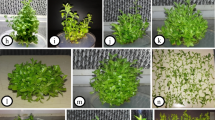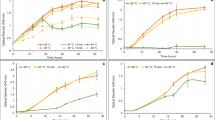Summary
A micropropagation protocol for Pouteria lucuma R. and Pav. var. La Molina, was developed. Shoots from zygotic embryos with a portion of endosperm were established in vitro on Murashige and Skoog (MS) medium with 0.47 μM kinetin (Kin) and 0.54 μM naphthaleneacetic acid (NAA). Multiplication of shoots was accomplished using subapical, shoots. The best axillary-shoot production was observed on MS basal, medium with 2.2μM, benzyladenine (BA), 0.5 μM NAA, 1.4. μM gibberellic acid (GA3), and 40 mgl−1 adenine sulfate, with the development of up to three axillary shoots per subapical shoot. One hundred percent rooting was obtained from shoots grown, for 4wk on MS medium with 246 μM indole-3-butyric acid under light conditions. Eighty percent of the microplantlets survived after acclimatization when transplanted to a substrate previously enriched with beneficial soil bacteria. This study describes, for the first time, arbuscular mycorrhizal (AM) colonization of this species. Inoculation with AM fungi improved growth and development of lucumo plants and induced changes to the root morphology.
Similar content being viewed by others
References
Cazorla, F. M.; Torés, J. A.; Olalla, L.; Perez-García, A.; Farré, J. M.; de Vicente, A. Bacterial apical necrosis of mango in southern Spain: a disease caused by Pseudomonas syringae pv. syringae. Phytopathology 88:614–620; 1998.
Duarte, O. Propagación del Lúcumo (Lucuma obovata H.B.K.) por estacas terminales con hojas. Acta Hort. 310:235–238; 1992.
Encina, C. L.; Barceló-Muñoz, A.; Herrero-Castaño, A.; Pliego-Alfaro, F. In vitro morphogenesis of juvenile Annona cherimola Mill. bud explants. J. Hort. Sci. 69:1053–1059; 1994.
Gardiazabal, F.; Valenzuela, L. Nuevas técnicas de propagación del Lúcumo. Rev. Frutícola 4:91–93; 1983.
Giovanetti, M.; Mosse, B. An evaluation of techniques for measuring vesicular arbuscular mycorrhizal infection in roots. New Phytol. 84:489–500; 1980.
Jordan, M.; Oyanedel, E. Regeneration of Pouteria lucuma (Sapotaceae) plants in vitro. Plant Cell Tiss. Organ Cult. 31:249–252; 1992.
King, E. D.; Ward, M. K.; Raney, D. E. Two simple media for the demonstration of pyocyanin and fluorescein. J. Lab. Clin. Med. 44:301–307; 1954.
Lovato, P. E.; Gianinazzi-Pearson, V.; Trouvelot, A.; Gianinazzi, S. The state of mycorrhizas and micropropagation. Adv. Hort. Sci. 10:46–52; 1996.
Muñoz, M. Nomenclatura del lúcumo cultivado en Chile. Agric. Técnica 47:416–418; 1987.
Murashige, T.; Skoog, F. A revised medium for rapid growth and bioassays with tobacco tissue cultures. Physiol. Plant. 15:473–497; 1962.
Naik, S. K.; Pattnaik, S.; Chand, P. K. High frequency axillary shoot proliferation and plant regeneration from cotyledonary nodes of pomegranate (Punica granatum L.). Sci. Hortic. 85:261–270; 2000.
National Research Council. Lost crops of the Incas: Little-known plants of the Andes with promise for world-wide cultivation. Washington, DC; National Academy Press; 1989.
Onguene, N. A.; Kuyper, T. W. Mycorrhizal associations in the rain forest of South Cameroon. For. Ecol. Manag. 140:277–287; 2001.
Padilla, I. M. G.; Encina, C. L. Micropropagation of adult cherimoya (Annona cherimola Mill.) cv. Fino de Jete. In Vitro Cell. Dev. Biol. Plant 40:210–214; 2004.
Phillips, J. M.; Hayman, D. S. Improved procedures for clearing roots and staining parasitic and vesicular-arbuscular mycorrhizal fungi for rapid assessment of infection. Trans. Br. Mycol. Soc. 55:158–161; 1970.
Rai, M. K. Current advances in mycorrhization in micropropagation. In Vitro Cell. Dev. Biol. Plant 37:158–167; 2001.
Rose, D. A. The description of the growth of the root system. Plant Soil 75:505–515; 1983.
Von, A. State of commercial use of AMF-inoculum in Germany. In: Gianinazzi, S.; Schuepp, H., eds. Arbuscular mycorrhizas in sustainable soil-plant systems. Report of 1997 activities. Iceland: Cost Action 8.21; 1998:153.
Wubet, T.; Kottke, I.; Teketay, D.; Oberwinkler, F. Mycorrhizal status of indigenous trees in dry Afromontane forest of Ethiopia. For. Ecol. Manag. 179:387–399; 2003.
Author information
Authors and Affiliations
Corresponding author
Rights and permissions
About this article
Cite this article
Padilla, I.M.G., Carmona, E., Westendorp, N. et al. Micropropagation and effects of mycorrhiza and soil bacteria on acclimatization and development of lucumo (Pouteria lucuma R. and Pav.) var. La Molina. In Vitro Cell.Dev.Biol.-Plant 42, 193–196 (2006). https://doi.org/10.1079/IVP2006749
Received:
Accepted:
Issue Date:
DOI: https://doi.org/10.1079/IVP2006749




